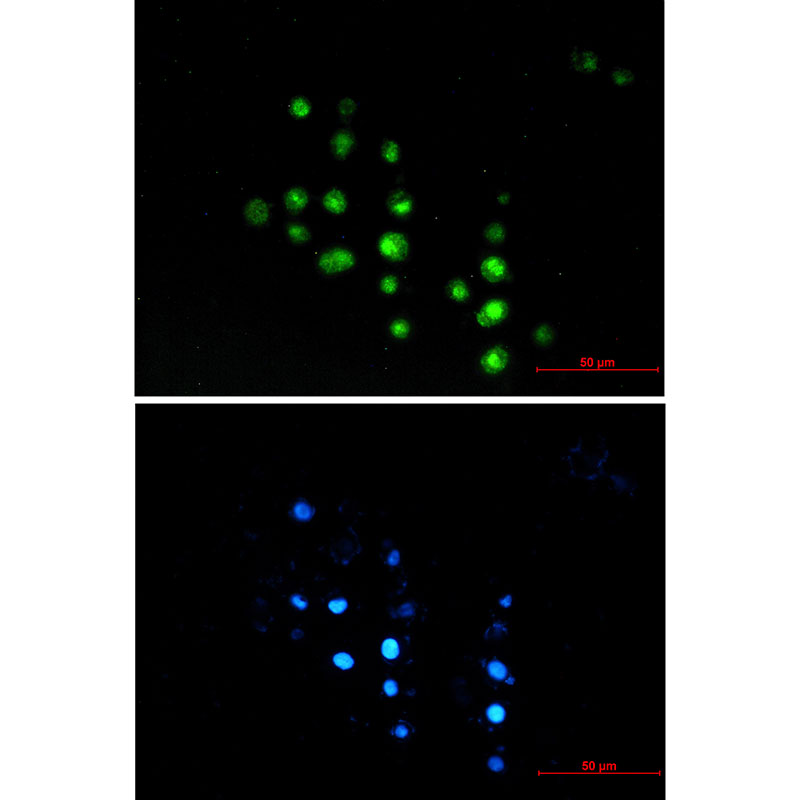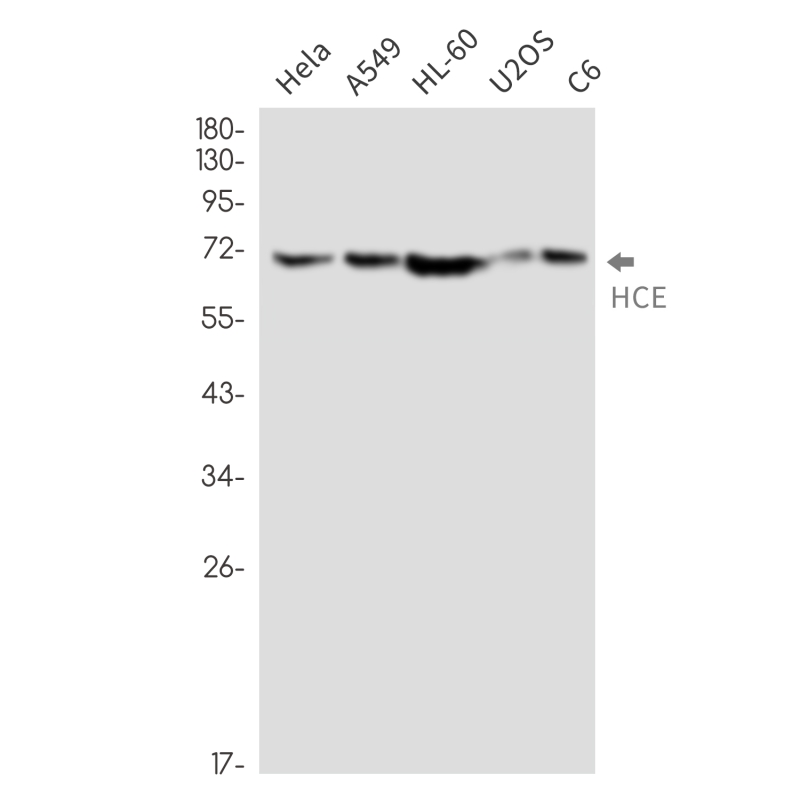

| WB | 1/500-1/1000 | Human,Mouse,Rat |
| IF | 1/20 | Human,Mouse,Rat |
| IHC | 咨询技术 | Human,Mouse,Rat |
| ICC | 1/50-1/200 | Human,Mouse,Rat |
| FCM | 咨询技术 | Human,Mouse,Rat |
| Elisa | 咨询技术 | Human,Mouse,Rat |
| Aliases | HCE; HCE1; hCAP; CAP1A |
| Entrez GeneID | 8732 |
| WB Predicted band size | Calculated MW: 69 kDa; Observed MW: 69 kDa |
| Host/Isotype | Rabbit IgG |
| Antibody Type | Primary antibody |
| Storage | Store at 4°C short term. Aliquot and store at -20°C long term. Avoid freeze/thaw cycles. |
| Species Reactivity | Human,Rat |
| Immunogen | Recombinant protein of human HCE |
| Formulation | Purified antibody in TBS with 0.05% sodium azide,0.05%BSA and 50% glycerol. |
+ +
以下是关于HCE(人角膜上皮细胞)抗体的模拟参考文献示例(仅供学术参考,实际文献需通过数据库验证):
1. **文献名称**:*"Role of HCE-specific antibodies in diagnosing autoimmune-related dry eye disease"*
**作者**:Smith J, et al.
**摘要**:本研究探讨了HCE抗体在干眼症中的诊断价值,发现血清中抗HCE抗体的水平与角膜上皮损伤程度呈正相关,提示其可作为自身免疫性干眼病的生物标志物。
2. **文献名称**:*"Mechanisms of HCE antibody-mediated corneal epithelial barrier dysfunction"*
**作者**:Zhang L, et al.
**摘要**:通过体外实验证实,HCE抗体可通过激活NF-κB通路破坏角膜上皮屏障功能,为治疗抗体相关角膜病变提供了潜在靶点。
3. **文献名称**:*"Autoantibodies against HCE in patients with Sjögren's syndrome: Clinical correlations"*
**作者**:Brown K, et al.
**摘要**:在干燥综合征患者中,HCE抗体的阳性率显著高于健康对照组,且与角膜荧光素染色评分密切相关,支持其在疾病活动监测中的应用。
4. **文献名称**:*"Proteomic identification of HCE antigenic targets recognized by autoimmune antibodies"*
**作者**:Patel R, et al.
**摘要**:利用蛋白质组学技术鉴定出HCE细胞中多个被自身抗体靶向的抗原蛋白(如KRT3、MUC16),揭示了角膜上皮免疫反应的分子机制。
---
注:以上内容为模拟示例,实际文献需通过PubMed、Web of Science等平台检索关键词(如"corneal epithelium antibodies"、"HCE autoantibodies")。建议结合具体研究方向筛选近年高质量论文。
**Background of HCE Antibodies**
HCE (Human Carbonic Anhydrase IX) antibodies are immunological tools targeting carbonic anhydrase IX (CAIX), a transmembrane enzyme overexpressed in hypoxic tumor microenvironments. CAIX plays a critical role in maintaining cellular pH homeostasis by catalyzing CO₂ hydration, supporting tumor survival, proliferation, and metastasis. Its expression is strongly associated with clear cell renal cell carcinoma (ccRCC) and other solid tumors, making it a biomarker for cancer diagnosis and prognosis.
HCE antibodies, primarily monoclonal, are used in research and diagnostics to detect CAIX via techniques like immunohistochemistry (IHC) and flow cytometry. They also hold therapeutic potential; antibody-drug conjugates (ADCs) or CAIX-targeting immunotherapies are under investigation to disrupt tumor metabolism or enhance immune responses.
Developed using hybridoma or recombinant technologies, HCE antibodies must exhibit high specificity to minimize cross-reactivity with other carbonic anhydrase isoforms (e.g., CAII or CAXII). Recent advances include humanized variants to reduce immunogenicity in clinical applications. Studies also explore their role in imaging, leveraging CAIX’s tumor-specific expression for precise detection.
Overall, HCE antibodies bridge diagnostic, therapeutic, and research realms, offering insights into tumor biology and advancing personalized oncology strategies.
×